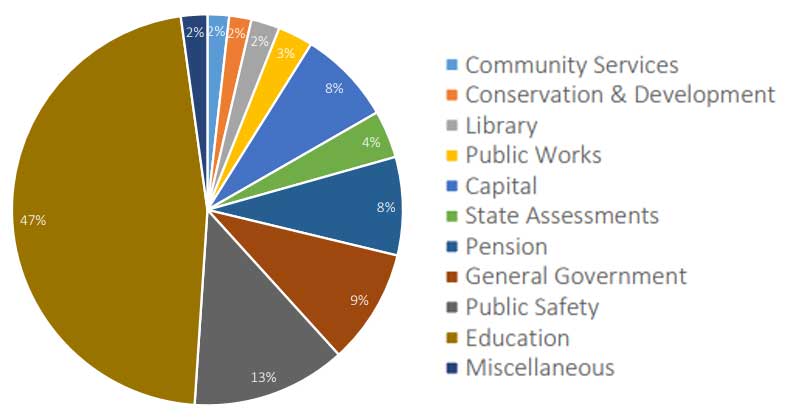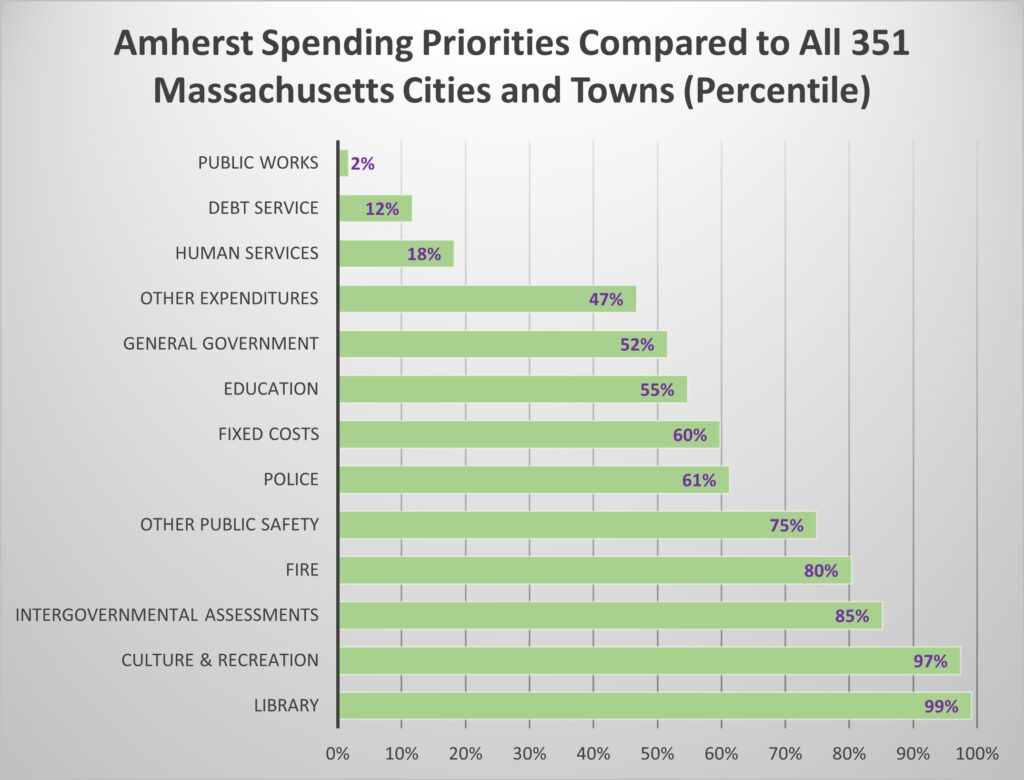Amherst’s Spending Priorities At A Glance

Pie Chart Representing Proposed Town of Amherst FY24 Budget. Source Amherstma.gov
Prompted by a recent discussion of Amherst’s highest and lowest spending priorities, concerned citizen Julian Hines has asked how an across-the-board look at how Amherst’s general fund expenditures compares to other Massachusetts cities and towns. Spending priorities, he points out, are decided by the Town Manager and Finance Director with direction from the Finance Committee and Town Council. He suggested that a better understanding of where Amherst spends its money might be helpful to citizens in deciding how to vote in the November town-wide election.
As requested, this graph examines the percentage of general fund expenditures spent by each of the state’s 351 municipalities across the 13 categories tracked by the Massachusetts Division of Local Services (DLS). The bars represent Amherst’s percentile when compared against the other 350 communities. Data is for fiscal year 2022.

For example, the 2.43% of its general fund expenditures that Amherst directs towards Public Works ranks the Town in the bottom 2% of cities and towns in the state. The 2.65% of general fund expenditures that Amherst spends on library services puts the Town in the top 1%. Note that this figure represents Amherst’s FY22 contribution to the Jones Library operating budget and does not include the appropriation of at least $15.8 million toward a renovated and expanded Jones Library if the project proves affordable.
DLS data is compiled from Schedule A statements that each municipality’s Finance Department is required to submit at the end of the year. Mathematician and former Selectman Rob Kusner has asked if the Public Works statistic includes Amherst’s expenditures for water and sewer which are paid for from enterprise funds supported by usage fees. My guess is no, as it seems reasonable that the general fund and the Town’s various enterprise funds would be reported separately. However, I have not found confirmation on the DLS website, nor do I know for certain how other cities and towns report their water and sewer expenses. The Town Finance Director would be able to answer with more authority.

Again Jeff,
How many other of the towns in MA have 3 library buildings? 3 Buildings comes at extra cost: 3 sets of utilities, 3 sets of maintenance, 3 sets of custodial, etc.
Are you really trying to point to the downsizing of our library options? The easiest cost cutting measure for the town would be to limit the number of physical libraries. Be careful what you wish for.
Marcus Smith
The town owns the branch library buildings. It’s like The Music Man—“He left River City the library building, but he left all the books to her [Marian]”.
What services and expenses are in Other Public safety?
CRESS, the separate police building line item, and some types of employee overtime I believe
Marcus, if you feel that the North Amherst and Munson Libraries represent fiscal fat that needs to be trimmed, I’m not here to argue with you. Go ahead and make a case to the Town Council, Finance Committee, Library Board of Trustees and The Amherst Indy for their elimination. You have every right, and that is how citizen democracy should work.
My only “wish” has been to present statistics pulled from the state’s data repository that reflect Amherst’s spending priorities. I do find it interesting that Amherst is near the top in Library spending and near the bottom in Public Works spending, but I leave it to readers to make of that what you will.
Over the years we have taken such pride in our schools being among the best in the Commonwealth.
Fifty-fifth percentile is shocking!
I suggest reworking the data if possible. Amherst has over $10 million in enterprise funds, the largest are water and sewer. These include expenses for DPW staff including those that spkit time with expenses paid by the general fund. Not all municipalities have such funds. Likely those without include in DPW.
Amherst also has a capital account with annual allocations to roads, sidewalk repairs and DPW equipment. The annual costs show up in capital not departments. I am not sure how other towns show capital for roads, snowblowers, etc related to DPW or Police vehicles.
Worth checking because we spend millions each year on roads, vehivkes, and equipment
I know this would be a lot of work. DLS staff can likely provide definitions and variations in how towns and cities report.
I understand your concern, Cathy, but I’m afraid I don’t have access to the information necessary to correct the Mass. Dept. of Revenue, if in fact their published data is inconsistent.
Does Amherst’s Finance Dept. have any insights into possible variations in how municipalities report financial data on the annual Schedule A forms that they submit to the state?
I think that’s a good question Cathy. We could ask the Finance Department or send an email to DLS.
The enterprise funds cover the Solid Waste Division, Water Department, and Water Pollution Control Division. Meaning the Highway Division (Think Roads and Sidewalks), as well as the Tree and Grounds Division, Engineering Division (Also Works on Roads and Sidewalks), Sign and Paint Division, Electrical Division, and Equipment Maintenance Division are all funded through the General Fund I believe, except for one truck driver position which is funded by the transportation enterprise fund.
This means many DPW services are not funded by enterprise funds and are directly comparable with other towns DPW funding. This includes all the maintenance of roads and sidewalks (pothole patching, shimming, sweeping, leveling, crack sealing, etc) which can extend roads lifespans.
The funding that goes to these divisions not in the enterprise funds also goes to some staff salaries, which are not keeping pace with inflation and average 67,000 per year.
Please correct me if any of this is incorrect, the FY24 budget book is where I found how most of this is broken up for anyone who is curious.